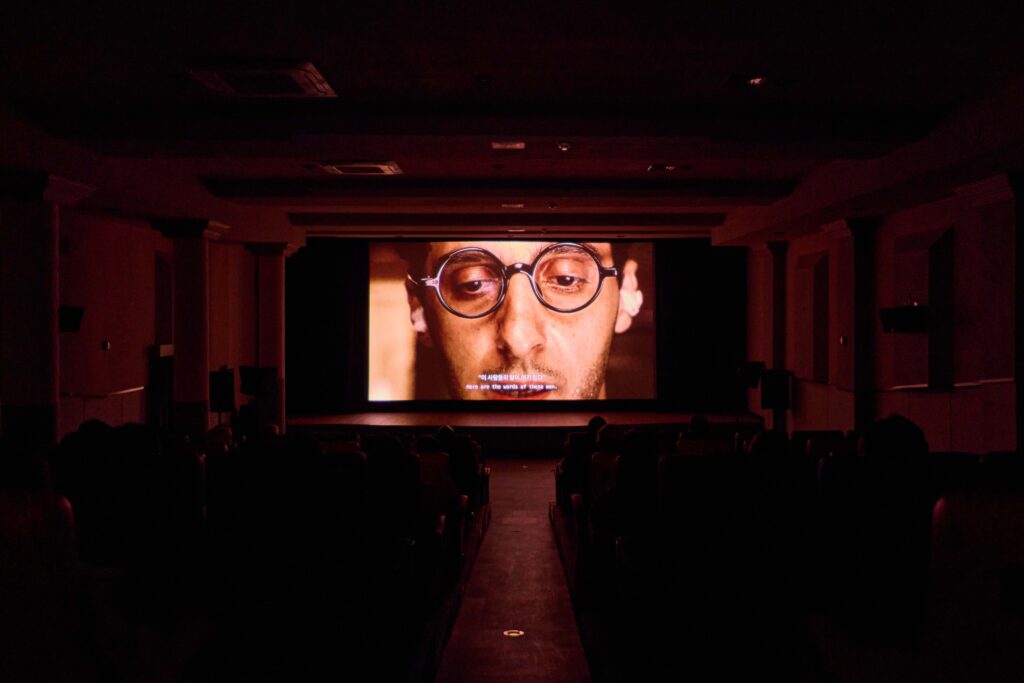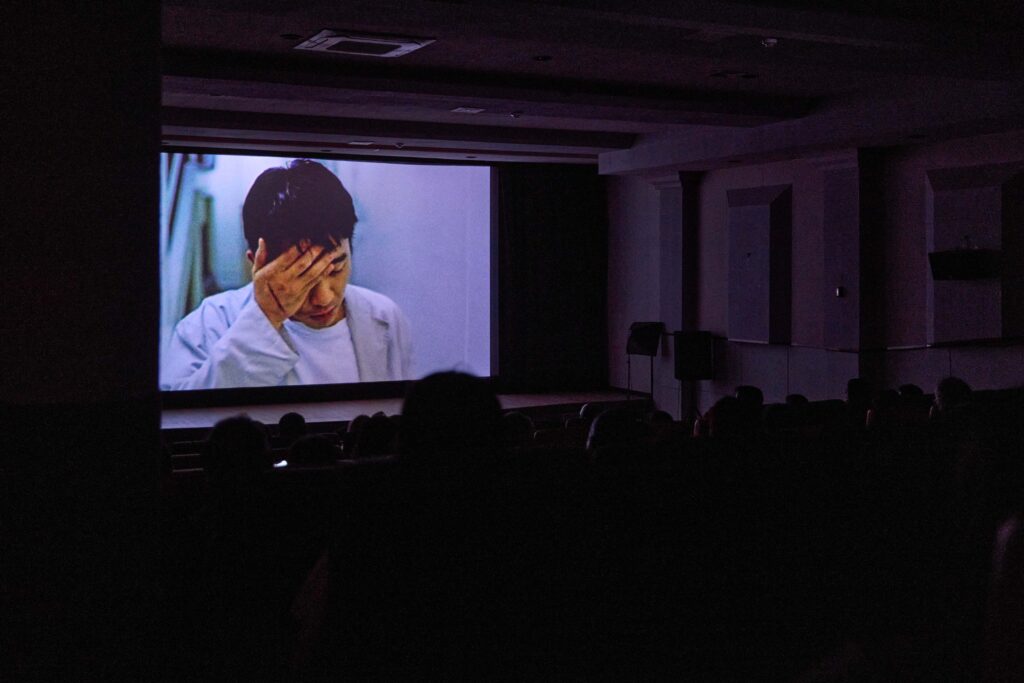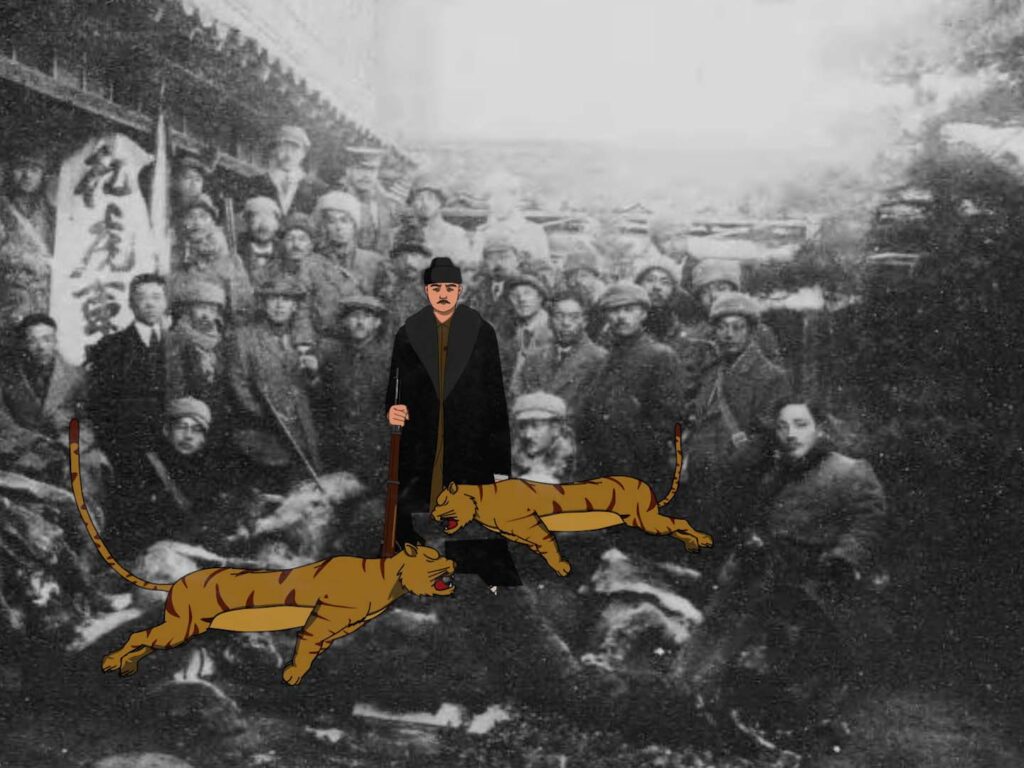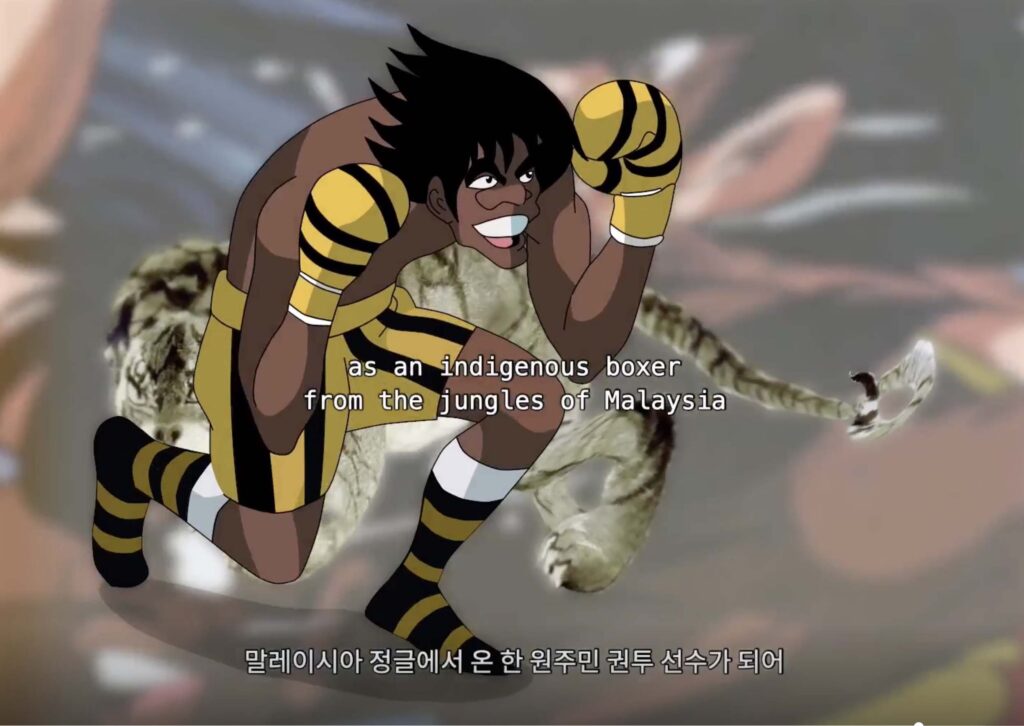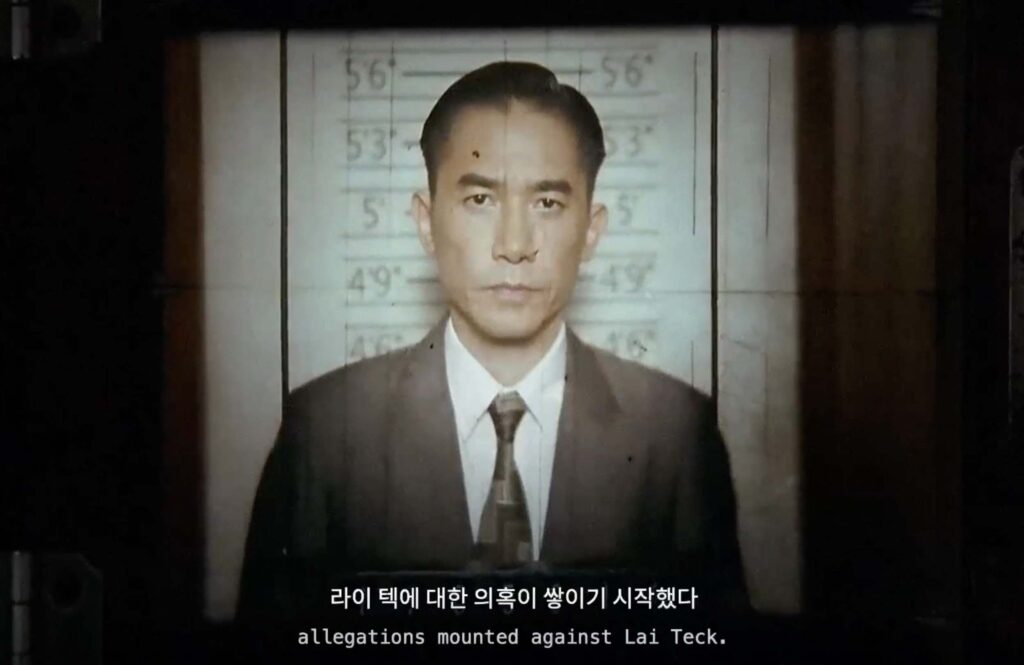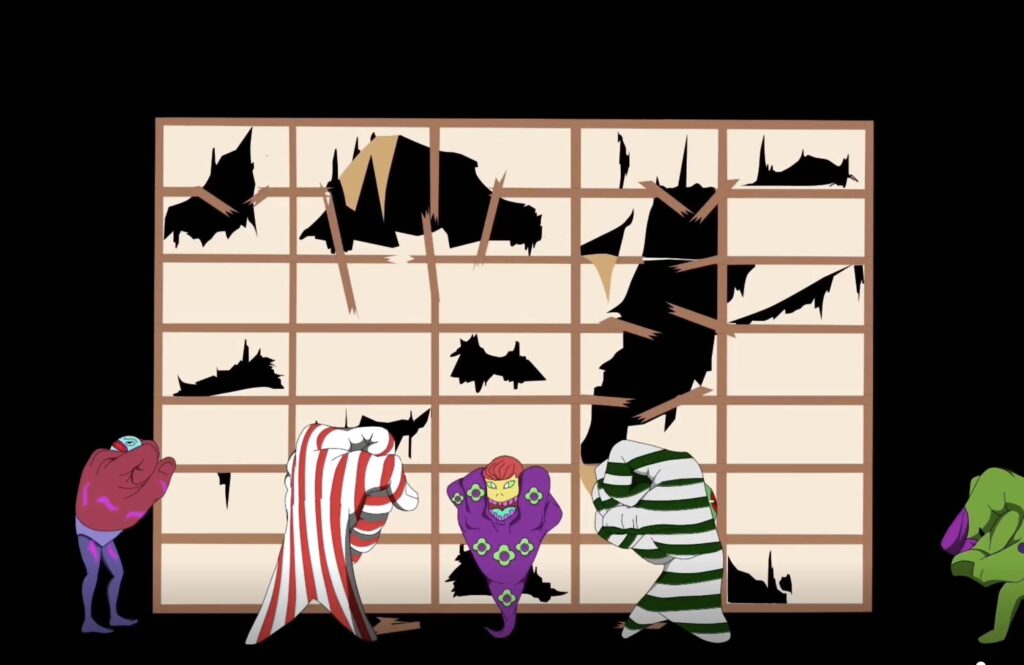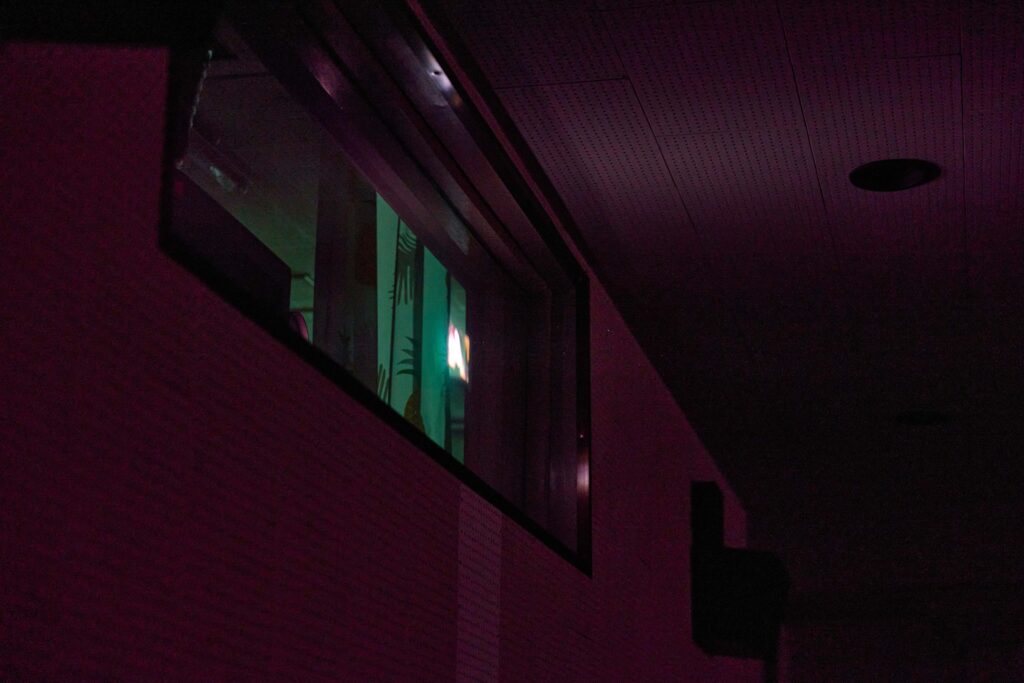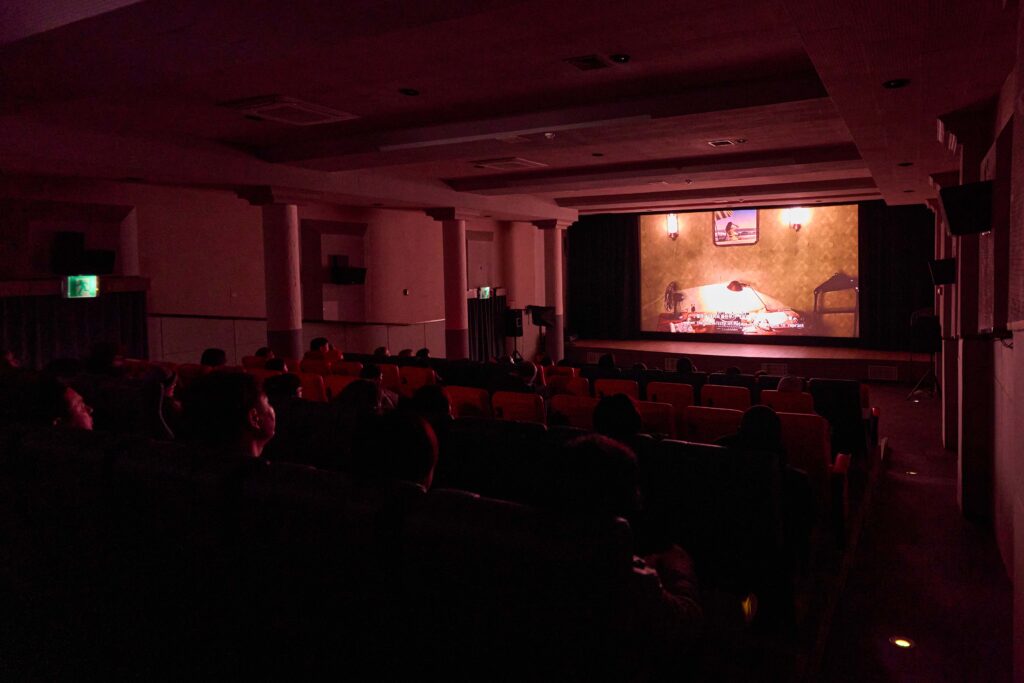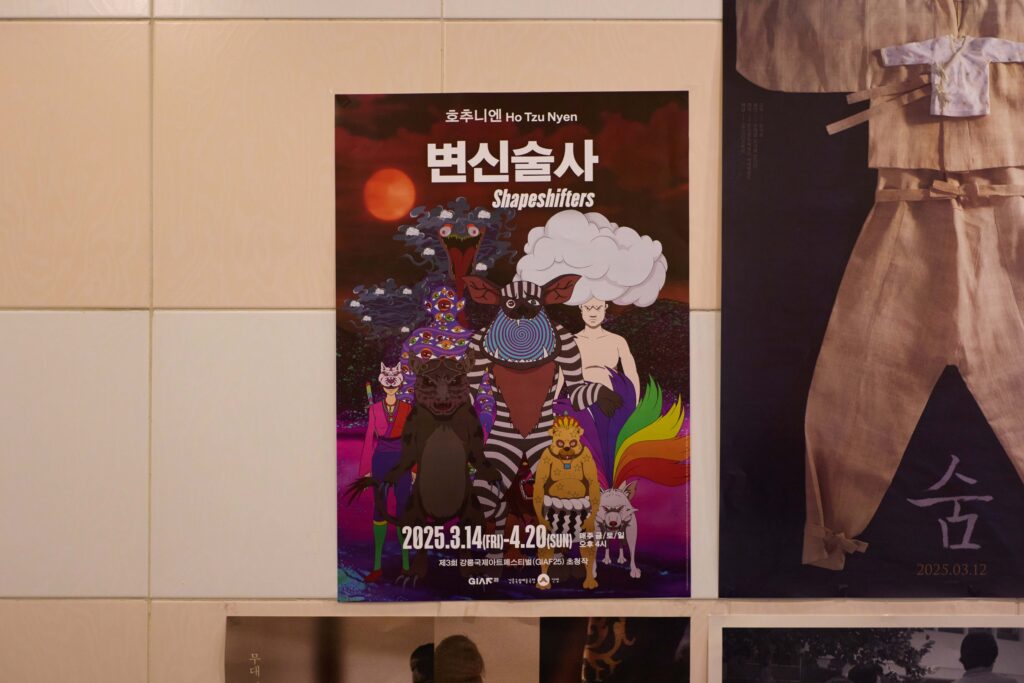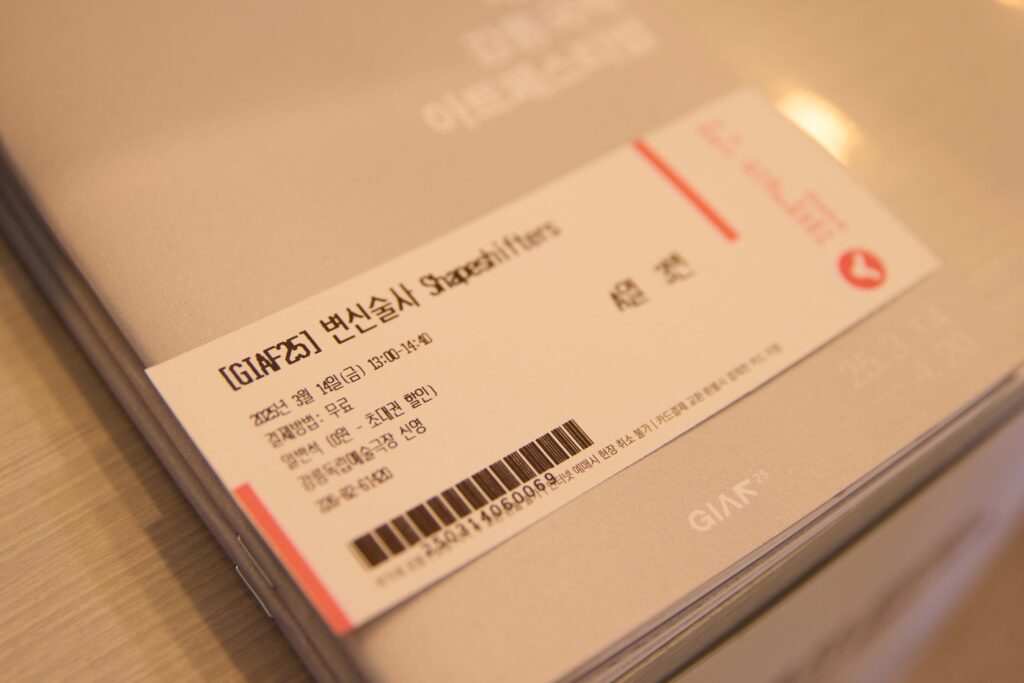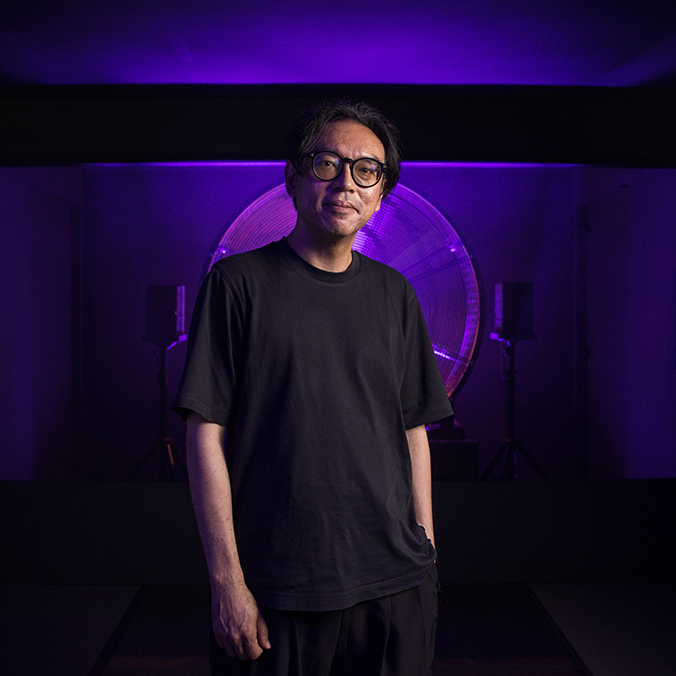EXHIBITION
ARTIST
- Shapeshifters, 2025, single-channel video, color, sound, 99 min.
Singaporean artist Ho Tzu Nyen delves into the histories, politics, and spiritual traditions of Southeast Asia. At GIAF25, Ho presented a curated screening program under the theme “Shapeshifters,” featuring five of his works. Through hybrid figures such as creatures and agents—entities that reside at the boundaries of categories— the artist examines how stories are created, circulated, and transformed. These figures serve as lenses through which the artist investigates overlapping forms of Asian modernity, revealing how histories are layered, fragmented, and continually rewritten.
By highlighting the complex interplay of identity, history, and narrative, Shapeshifters aligns with the festival’s thematic focus on old stories. Just as the Silla-era ballad Myeongju-ga evolved into the myth of Lady Yeonhwa in Gangneung folklore, stories continuously morph through generations. Ho’s films capture this phenomenon, showing how past and present are always in flux, shaped by the countless voices that carry stories forward.
Screening list
1. The Nameless, 2015, 21min. 50sec.
2. The Name, 2015, 17min. 20sec.
3. 36 Ghosts, 2021, 20min.
4. 1 or 2 Secret Agencies, 2021, 20min.
5. 1 or 2 Tigers, 2021, 20min.
Korean translation and screening commissioned by Gangneung International Art Festival 2025 (GIAF25).
1. The Nameless, 2015, 21min 50sec.
Synopsis
The Nameless is about a person known as Lai Teck, which was one of the 50 known aliases of the Secretary-General of the Malayan Communist Party from 1939 to 1947, when he was killed in Thailand, after being exposed as a triple agent—working first for the French then British secret forces, then with the Japanese Kempeitai during the years of the Malayan Occupation.
But The Nameless is also about cinema, and acting. Of all the great cinematic cultures of the world, it is perhaps Hong Kong cinema that has shown a most intense fascination with “compromised” individuals, as evident from the constant stream of Hong Kong films about “stool pigeons”, “double-agents”, “informers” and “traitors”.
A film about a shapeshifter, told through a series detourned images, featuring an actor from a land of manifold allegiance, told through multiple languages.
Credits1
Sources2
2. The Name, 2015, 17min 20sec.
Synopsis
Gene Z. Hanrahan was the first writer who attempted to compose a comprehensive historical account of the Malaysian communist party, and also produced a wide variety of other writings, including “historical” as well as “literary” works. His diverse interest imbues his overall oeuvre with the impression that they comprise pieces written by disparate individuals using a shared alias rather than a single author. Today, there are substantial reasons to consider Gene Z. Hanrahan as a ghost-writer, with links to the CIA.
The Name is constructed out of footage appropriated from various Western films showing actors engaged in the act of writing. The spoken text that accompanies The Name consists of excerpts from various books “written” by Hanrahan, and are recited by professional American voice actors, who infuse Hanrahan’s character with life by reading excerpts of his writings.
The Name was originally configured as a single channel video projection, installed along with books edited or written by the author Gene Z. Hanrahan, many of them rare, out-of-print books that were collected by Ho Tzu Nyen since 2014.
Credits3
Sources (image, sound)4
Citations(text)5
3. 36 Ghosts, 2021, 20min.
Synopsis
36 Ghosts explores the associations of Japanese Yokai with war, particularly the new tales that emerged with the Pacific War. These creatures remained firmly embedded in everyday imagination, with wartime fears and desires of the masses unconsciously spilling out into the world as Yokai. In 36 Ghosts, some tales of Yokai are informed by Japan’s invasion of Malaya and other Southeast Asian countries: Two ‘Tigers of Malaya,’ General Yamashita Tomoyuki and vigilante Tani Yutaka, are present as weretigers; the Bake-neko (Monster Cat) and the Himamushi-nyudo (Firebug Monk), two Yokai traditionally believed to have the habit of licking oil from lanterns, are tied to the search for resources such as oil through the invasion of Southeast Asia during the war. Together, the tales woven about these creatures illuminate attempts to understand the self through monstrosity.
Cast & Credits6
4. 1 or 2 Secret Agencies, 2021, 20min.
Synopsis
In 1938, Japan established the Nakano Army School as a place to educate and train potential agents in intelligence, counter-intelligence, and propaganda. Only the most gifted were recommended by various army units and universities for possible entry into the Nakano School, and those who passed the barrage of difficult tests were seen as geniuses. Graduates from the Nakano School would later head the F-Kikan (F-Agency), a secret service founded in 1940 in South and Southeast Asia. 1 or 2 Secret Agencies overlays animation and live-action to blur boundaries between the fictional and the historical narratives surrounding the shifting identities of the spies that progressed through the Nakano School. The numerous spies that appear follow varied pathways, some giving up their lives for their country or their government, while others become agents of their own lives.
Cast & Credits7
5. 1 or 2 Tigers, 2021, 20min.
Synopsis
1 or 2 Tigers delves into the narratives of two Japanese individuals each known as the ‘Tiger of Malaya.’ General Yamashita Tomoyuki, commander of the 25th Army, was known as the ‘Tiger of Malaya’ for his defeat of superior forces during the 1942 invasion of Singapore. The other ‘Tiger of Malaya’ was Tani Yutaka, a Malayaraised Japanese bandit known as ‘Harimau’ (Malay for ‘Tiger’), regarded by some as a hero who sided with the poor and the weak. Tani was later persuaded by Kamoto Toshio, a Nakano School-trained spy from the F-Agency, to become a spy to oppose the British army. Tracing the historical emergence of tiger imagery in East Asian paintings up till contemporary Japanese animation, tigers recur in 1 or 2 Tigers as the phantoms of wartime histories.
Cast & Credits8
Ho Tzu Nyen (b. 1976) is a Singaporean artist whose work incorporates a wide range of elements, including cultural references from both East and West, as well as art history, theater, film, music, and philosophy. By blending mythical narratives with historical facts, he explores various understandings of history, its documentation, and its transmission. The central theme of his work is a long-term study of Southeast Asia’s multicultural identity. He perceives Southeast Asia as a region of immense diversity in terms of language, religion, culture, and external influences—a complex space that cannot be explained merely as a geographical area or through various knowledge systems, narratives, and modes of expression. Ranging from documentary research to fantasy, his works employ archival images, animation, and film to create immersive and dramatic installations.
Ho Tzu Nyen has held solo exhibitions at major international institutions including LUMA Arles (2025), Mudam Luxembourg (2025), Hessel Museum of Art (2024), Art Sonje Center (2024), Museum of Contemporary Art Tokyo (2024), Singapore Art Museum (2023), Hammer Museum (2022), Toyota Municipal Museum of Art (2021), Crow Museum of Asian Art (2021), YCAM – Yamaguchi Center for Arts and Media (2021), Edith-Russ-Haus for Media Art (2019), Kunstverein in Hamburg (2018), McaM – Museum of Contemporary Art Shanghai (2018), Asia Art Archive (2017), Guggenheim Museum Bilbao (2015), and Mori Art Museum (2012). In 2011, he represented Singapore at the 54th Venice Biennale. Together with Taiwanese artist Hsu Chia-wei, he also co-curated the 7th Asian Art Biennale, The Strangers from Beyond the Mountain and the Sea (2019), at the National Taiwan Museum of Fine Arts. He has been appointed Artistic Director for the 16th Gwangju Biennale in 2026.
- Chinese voice: Song Yuzhe
Vietnamese voice: Hung Manh Le
Chinese translation: Low Kah Wei
Vietnamese translation: Aaron Hasche
Sound Mix: Titus Maderlechner
Color Grading: Carolin Röckelein
↩︎ - 1989 – City of Sadness by Hou Hsiao Hsien, 157 min
1990 – Bullet in the Head by John Woo, 136 min
1990 – Days of Being Wild by Wong Kar Wai, 94 min
1992 – Hard Boiled by John Woo, 1992, 128 min
1994 – Ashes of Time by Wong Kar Wai, 100 min
1994 – Chungking Express by Wong Kar Wai, 94 min
1995 – Xich lo (Cyclo) by Tran Anh Hung, 123 min
1997 – Happy Together by Wong Kar Wai, 96 min
1998 – The Longest Nite by Patrick Yau, 81 min
2000 – In the Mood for Love Wong Kar Wai, 98 min
2002 – Infernal Affairs (Part 1) by Andrew Lau and Alan Mak, 101 min
2004 – 2046 by Wong Kar Wai, 129 min
2007 – Lust Caution by Ang Lee, 157 min
2011 – The Great Magician by Yee Tung-Shing, 128 min
2012 – The Silent War by Felix Chong and alan Mak, 120 min
2013 – The Grandmaster by Wong Kar Wai, 130 min
↩︎ - Directions, script, edit, sound: Ho Tzu Nyen
Project manager: Stephanie Goh
Sound mix and audio engineer: Titus Maderlechner
Color grading: Carolin Röckelein
Research consultant: Marc Opper
Chinese translation and voice: Tay Kong Hui
American voices: Peter Gilbert Cotton
Jonathan Failla
Tom Strauss
Project originally commissioned by Ariane Beyn forexhibition The Name (2015) at daadgalerie, Berlin
Special Thanks: Bettina Klein, Marc Opper
↩︎ - 1980 – The Shining by Stanley Kubrick, 144 min
1982 – Deathtrap by Sidney Lumet, 116 min
1987 – Barfly by Barbet Schroeder, 100 min
1990 – Misery by Rob Reiner, 107 min
1991 – Barton Fink by Joel and Ethan Coen, 116 min
1991 – Kafka by Steven Soderbergh, 98 min
1991 – Naked Lunch by David Cronenberg, 115 min
1994 – The Hudsucker Proxy by Joel and Ethan Coen, 111 min
1997 – Deconstructing Harry by Woody Allen, 96 min
2000 – Wonder Boys by Curtis Hanson, 107 min
2000 – Finding Forrester by Gus Van Sant, 136 min
2002 – Adaptation by Spike Jonze, 114 min
2004 – Secret Window by David Koepp, 96 min
2005 – Capote by Bennett Miller, 114 min
2005 – Factotum by Bent Hamer, 94 min
2006 – Half Light by Craig Rosenberg, 110 min
2006 – Ask the Dust by Robert Towne, 117 min
2007 – 1408 by Mikael Håfström, 104 min
2007 – Atonement by Joe Wright, 123 min
2008 – Gonzo by Alex Gibney, 120 min
2010 – The Ghost Writer by Roman Polanski, 128 min
2010 – Howl by Rob Epstein and Jeffrey Friedman, 84 min
2011 – The Rum Diary by Bruce Robinson, 120 min
2012 – Hemingway & Gellhorn by Philip Kaufman, 155 min
2012 – The Master by Paul Thomas Anderson, 144 min
2013 – Kill Your Darlings by John Krokidas, 104 min
↩︎ - 1943 – William J. Kennedy, Pre-Service course in Shop Practice, U.S.A., New York: John Wiley & Sons, INC., 1943, republished by India, New Delhi: Isha Books, 2013.
*According to the Library of Congress Catalogue, William J. Kennedy is the pseudonym of Gene Z. Hanrahan.
1954 – Gene Z. Hanrahan, The Communist Struggle in Malaya, U.S.A, New York: Institute of Pacific Relations 1954, republished by Malaysia, Kuala Lumpur: The University of Malaya Press in 1979.
1954 – Gene Z. Hanrahan, Japanese Operations Against Guerilla Forces , U.S.A., Maryland: Operations Research Office, The John Hopkins University.
1962 – Gene Z. Hanrahan (ed.), ASSAULT! True Action Stories of the Island War in the Pacific, selected, edited and introduced by Gene Z. Hanrahan, U.S.A., New York: Bantam Books.
1962 – Gene Z. Hanrahan (ed.), Hemingway – The Wild Years selected, edited and introduced by Gene Z. Hanrahan, U.S.A, New York: Dell Publishing.
1965 – Gene Z. Hanrahan (ed.), ‘Foreword’ to 50 Great Oriental Stories, selected, edited and introduced by Gene Z. Hanrahan, U.S.A., New York: Bantam Books.
1974 – Gene Z. Hanrahan, Communist Guerilla Warfare Tactics, U.S.A., Colorado: Paladin Press.
1981 – Gene Z. Hanrahan (ed.), The Murder of Madero, and the Role Played by the U.S. Ambassador Henry Lane Wilson, Volume IV of Documents on the Mexican Revolution, U.S.A., North Carolina: Documentary Publications.
1981 – Gene Z. Hanrahan (ed.), The Election of Madero, the Rise of Emiliano Zapata and the Reyes Plot in Texas, Volume III of Documents on the Mexican Revolution (U.S.A., North Carolina: Documentary Publications.
1982 – Gene Z. Hanrahan (ed.), Blood Below the Border – American Eyewitness Accounts of the Mexican Revolution, U.S.A., North Carolina: Documentary Publications.
1983 – Gene Z. Hanrahan (ed.), to Counter Revolution Along the Border, Volume VII of Documents on the Mexican Revolution, U.S.A., North Carolina: Documentary Publications.
1983 – Gene Z. Hanrahan (ed.), The Rebellion of Felix Diaz, Documents on the Mexican Revolution, Volume VIII (U.S.A., North Carolina: Documentary Publications.
1985 – Gene Z. Hanrahan (ed.), The Terrorist Classic: Carlos Marighella, Manual of the Urban Guerilla, U.S.A., North Carolina: Documentary Publications.
1985 – Gene Z. Hanrahan (ed.), The Bad Yankee / El Peligro Yankee – American Entrepreneurs and Financiers in Mexico, Documents on the Mexican Revolution Volume IX (U.S.A., North Carolina: Documentary Publications.
1992 – Cheah Boon Kheng, From PKI to the Comintern, 1924 – 1941: The Apprenticeship of the Malayan Communist Party, U.S.A, New York: Cornell University Press, Southeast Asia Program Publications.
↩︎ - Directions, Script, Edit, Sound Co-Design, Co-Producer: Ho Tzu Nyen
Research, Script Collaboration, Translation (Japanese): Yoko Nose
Translation (Japanese): Tomoyuki Arai
Artist Assistant, Production Manager, Subtitles: Johann Yamin
Artist Assistant, Production Coordinator: Janfer Chung
Co-Producer: Stephanie Goh
Animation and Foley: Screen Breathes Studio
Animation Producer: Sirius Black
Sound Mix: Jeffrey Yue
Additional Sound Mixing: Cheng Lijie
Music Composer: Aki Onda
Voice: Phew
Sound Engineer: Toshihiko Kasai
First commissioned by: Toyota Municipal Museum of Art, Japan
Supported by: National Arts Council, Singapore and Kiang Malingue
↩︎ - Directions, Script, Edit, Sound Co-Design, Co-Producer: Ho Tzu Nyen
Research, Script Collaboration, Translation (Japanese): Yoko Nose
Dramaturgy, Research, Script Collaboration, Translation (Japanese): Tomoyuki Arai
Artist Assistant, Production Manager, Subtitles: Johann Yamin
Artist Assistant, Production Coordinator: Janfer Chung
Co-Producer: Stephanie Goh
Animation and Foley: Screen Breathes Studio
Animation Producer: Sirius Black
Sound Mix: Jeffrey Yue
Additional Sound Mixing: Cheng Lijie
Music Composer: Aki Onda
Kora, Fife, Casio Tone: Nao Nishihara
Sound Engineer: Toshihiko Kasai
Assistant Sound Engineer: Takuma Kase
First commissioned by: Toyota Municipal Museum of Art, Japan
Supported by: National Arts Council, Singapore and Kiang Malingue
↩︎ - Directions, Script, Edit, Sound Co-Design, Co-Producer: Ho Tzu Nyen
Research, Script Collaboration, Translation (Japanese): Yoko Nose
Dramaturgy, Research, Script Collaboration, Translation (Japanese): Tomoyuki Arai
Artist Assistant, Production Manager, Subtitles: Johann Yamin
Artist Assistant, Production Coordinator: Janfer Chung
Co-Producer: Stephanie Goh
Animation and Foley: Screen Breathes Studio
Animation Producer: Sirius Black
Sound Mix: Jeffrey Yue
Additional Sound Mixing: Cheng Lijie
Music Composer: Aki Onda|
Taepyeongso, China Cymbal, Jing: Nao Nishihara
Sound Engineer: Toshihiko Kasai
First commissioned by: Toyota Municipal Museum of Art, Japan
Supported by: National Arts Council, Singapore and Kiang Malingue ↩︎
